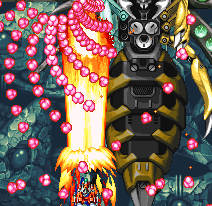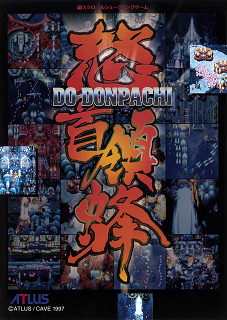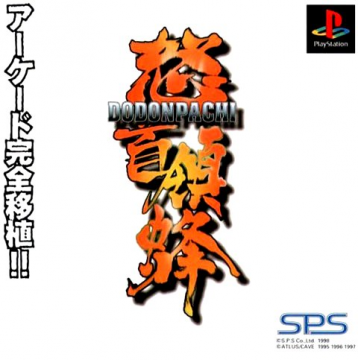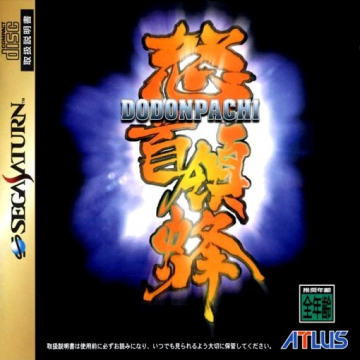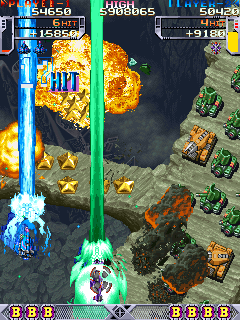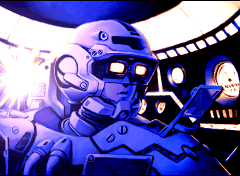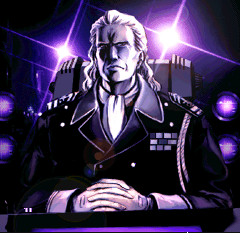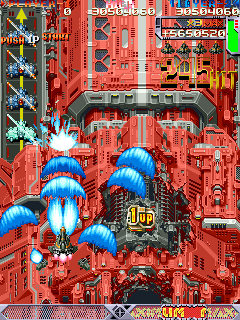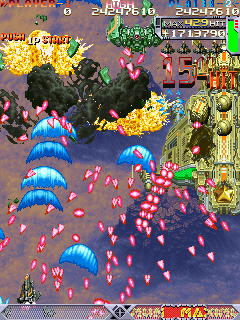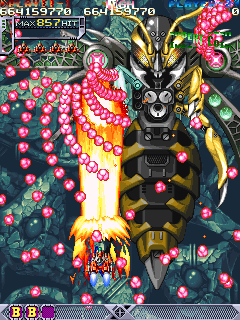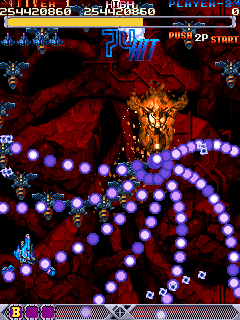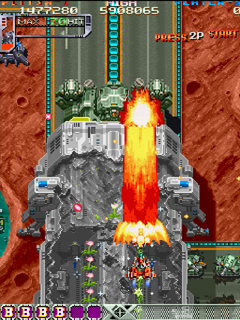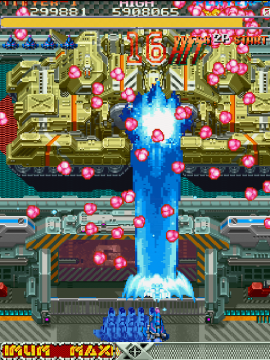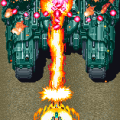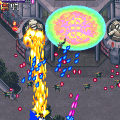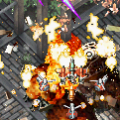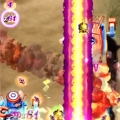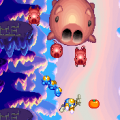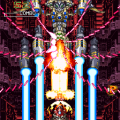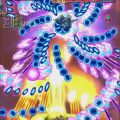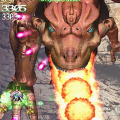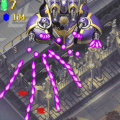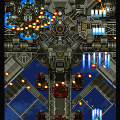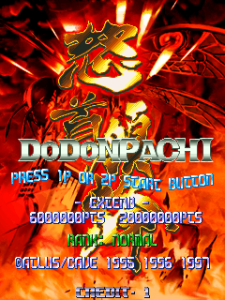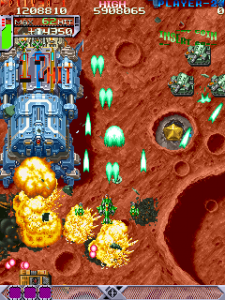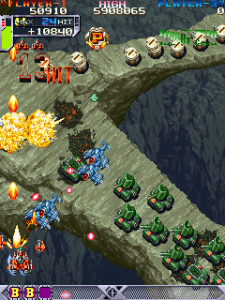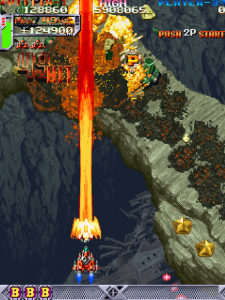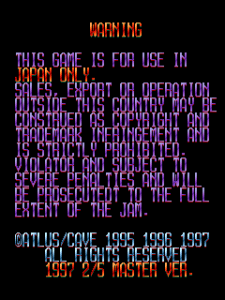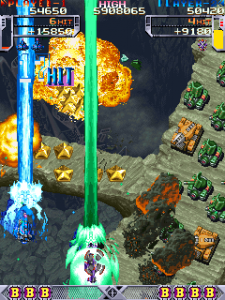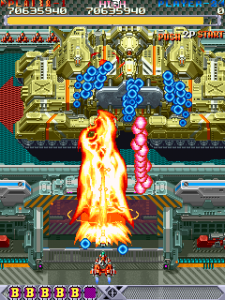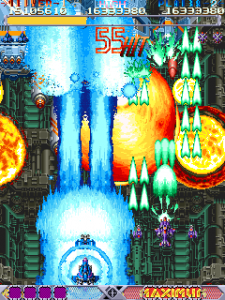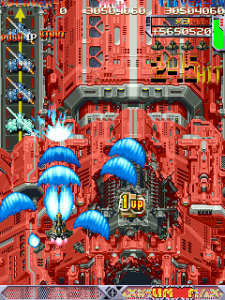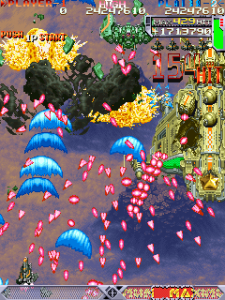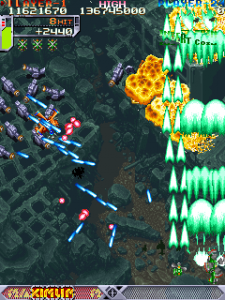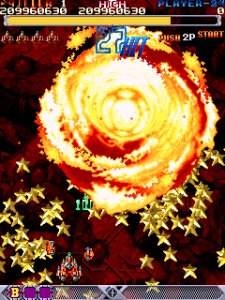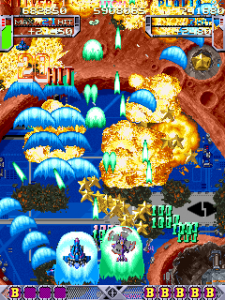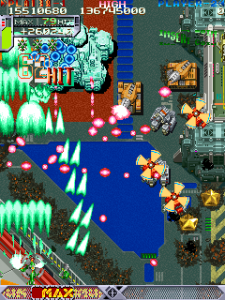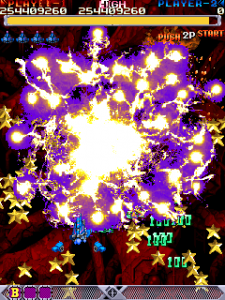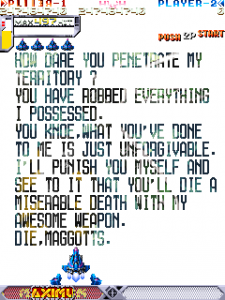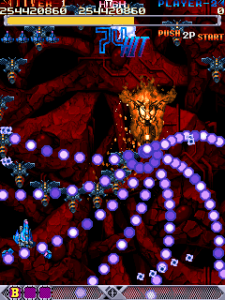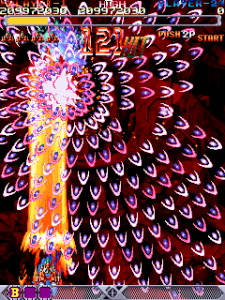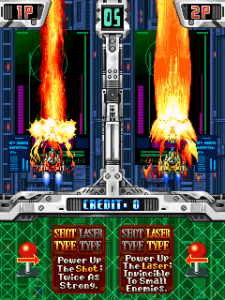Shinu Ga Yoi (Dying Is Good)
Donpachi was a hit in arcades, and people felt that Cave were picking up right where Toaplan left off. Therefore, it’s no surprise that a sequel to Donpachi would soon be in development. The feeling that the developers had when making Dodonpachi (lit. “Angry Leader Bee”), was to ignore the “Toaplanishness” of Donpachi, instead only putting in systems that Cave felt were the most interesting. This lead to a far more balanced and refined game than its predecessor. To sum up Dodonpachi in a single word, it would have to be…more. More enemies, more stages, more bosses, more systems, more dodging, more bullets, more…everything. The cause of this “more” feeling stems from a chance encounter with the Raizing game Battle Garegga that main programmer Tsuneki Ikeda experienced. The intense action and immediate difficulty of Battle Garegga left a strong impact on Ikeda, leaving him with the feeling that “We (Cave) have to surpass Battle Garegga. Ikeda knew that he couldn’t make a game like Battle Garegga no matter how hard he tried, so if he wanted to surpass it, it would have to be done through different means, bullet dodging. Ikeda would later reveal in an interview that he told his team that “We won’t lose in terms of bullets!” When released, Dodonpachi could have up to 245 bullets onscreen at once. Because of that decision, Dodonpachi went on to solidify the bullet-hell sub-genre. Dodonpachi would be released into Japanese arcades on February 5, 1997. The game introduced several of what would become the series mainstays: The Donpachi Squadron, Colonel Schwarlitz Longhena, and his “Final Brutal Weapon”: Hibachi.
Story
Dodonpachi takes place many years after the founding of the Donpachi Squadron. Communication with the 7th Starship Corps has suddenly ceased while they were circulating the outside of the star cluster system. Soon after, an unknown army comprised of “Mechanized Aliens” launched an attack upon our forces. When our armada had arrived to intercept this new threat, they found that the attackers had completely vanished from the radar. With the sense of unease growing with each passing day, Colonel Schwarlitz Longhena came up with a plan to eliminate the Mechanical Alien army, and called upon one of his “worker bees” to prepare to sortie. The plan was for this elite pilot to go in alone, and single-handedly destroy the entire army. Thus is the fate of the worker bee, surely it was merciless beyond reason.
(Should the player meet the second loop requirements)
As the last enemy fell, the pilot received an incoming call from the Colonel. “That was a good fight, you should be commended…Psych! You’re dead meat!” The Colonel went on to reveal that the army the pilot had destroyed was actually the pilot’s fellow comrades of the missing 7th Starship Corps; and that the “Mechanized Alien army” had been fabricated by the Colonel himself. The Colonel then informs the pilot that their death would be a fitting end to his plot, and that he’s sending the entire Donpachi Squadron to welcome the pilot home with fierce firepower. It seems that a worker bee’s job is never done.
Characters
Player
A member of the Donpachi Squadron. After receiving orders directly from the Colonel, he and another pilot (Player 2) are to pilot the New-Type Ultra Annihilation Fighter Craft (DO-N82) against the Mechanical Alien army, alone. After launching from the transport ship, their only assistance in this mission will be through the operator on board the transport ship. Whether they succeed or fail, is all up to them, and them alone.
Gameplay
The controls of Dodonpachi are the same as they were in Donpachi. Players can move the ship in eight directions by tilting the joystick, and the game itself only requires two buttons to play. Pressing and releasing the A button fires a salvo of Shots from the player’s ship, and holding down the A button will fire a powerful Laser, at the cost of movement speed. Pressing the B button releases a Spread Bomb, or Laser Bomb, if the A button is held, which clears the screen of bullets, damages enemies, and makes the player temporarily invincible while active. The three ships in Dodonpachi are the same three ships used in Donpachi. However, this time players can choose to make either their ship’s Shot or Laser more powerful. Choosing to power-up the Shot, causes the ships’ center shot to fire twice the number of projectiles than normal. Choosing to power-up the Laser makes the player invincible to small enemies just like the Aura effect from Donpachi. The Shot type fighters do have a Laser Aura, but it is much smaller and weaker than the Laser Type version.
Power-ups work a bit differently in Dodonpachi than they did in Donpachi. It no longer takes seven power-ups to reach the maximum shot level, instead only requiring four. Additionally, collecting a “B” icon when a player’s bomb stock is full will not only award the player with 10,000 points, but trigger the MAXIMUM bonus, which will be explained later. The thirteen hidden be icons in every stage return, as do their score bonus. Also making a return are the star chips. In Dodonpachithere are three types of stars chips. The first type of stars are the small stars in pentagons, which can only be found on the ground, are worth 300 points. The second type are the tiny free-floating stars that drop from various aerial enemies; these stars are worth 100 points. The third type of star are the huge free-floating stars that can appear both on ground and in air, and are worth 10,000 points each.
Despite the catchphrase, dying is very bad in Dodonpachi. Every time the player dies, they will gain a bomb-slot (if available) and all of their bombs will be refilled. After the second time the player dies, a “P” item will be released, with two being released on the third death, three on the fourth, etc. If a Player dies on their last life, an “MP” item will appear, and will power-up the ship to maximum power if collected. However, continuing will prevent the player from accessing the game’s second loop. Additionally, if the player is playing a Shot Type ship, the power of the ship’s Laser will be reduced to the starting level, and vice versa for Laser Type ships. Collecting enough power-ups will eventually get the ship’s laser and shot back to their max level (noted by the “P” icons giving 10,000 points).
Like the previous game, Dodonpachi features a second loop, but unlike the previous game, this loop can only accessed by satisfying at least one of four conditions. To reach the second loop, the player must score at least 50 million points, collect all thirteen bees in four of the six stages, not lose more than two fighters, or have a maximum hit count at or above a certain number: 270 for Type-A; 300 for Type-B; and 330 for Type-C ships. If the player achieves at least one of the aforementioned criteria, and not continue during the first loop, they will restart the game from Stage 1, but on a much harder difficulty. Successfully completing Stage 6 of the second loop triggers two additional boss fights, also contains two hidden bosses: Taisabachi, and the game’s True Last Boss, Hibachi. Just reaching the second loop will allow players to combat these fearsome foes, even if they continue. Players cannot enter the second loop if they continue during the first loop, regardless if the conditions to enter were met.
Scoring
There are many different ways to increase a player’s score in Dodonpachi. The GPS (Get Point System) system returns in Dodonpachi, with some heavy tweaking and new visual cues make the system much more forgiving, and enjoyable than it was in Donpachi. In the upper-left corner of the screen, there is now a vertical bar on the left-side of the max HIT count and a point display above the player’s remaining lives. This bar represents the time remaining in the current chain. When the player destroys an enemy, the some of the bar will be refilled, and begin to rapidly tick down once again. It takes about a second for the bar to go from full to completely empty. Players have a few different ways they can keep their chain active. The most obvious method is to destroy something else with the Laser or Shot, just like in the previous game. A new method introduced in Dodonpachi is the ability to “stall” the bar by hitting large enemies or buildings with the Laser. Doing so will prevent the bar from fully draining (holds it at about ten percent), and periodically raise the hit counter. It also allows just enough time to hit another large enemy or destroy a smaller one immediately after destroying the first large enemy, and thus continuing the chain. And, thanks to some thoughtful stage layouts and the increased chain timer, it is now possible to chain entire stages for huge points! The GPS works a little differently in boss battles, as the timer has been removed. Instead, the hit counter increases whenever the boss is hit by the player’s Laser or Laser Bomb, and decreases otherwise. Hitting destroyable boss parts will add to this counter, but hitting enemies released after the boss fight began will not. Score-wise the GPS works like this: when a player destroys enemy in a chain, the point value of that enemy, and the point value of all other enemies destroyed in that chain are added to the player’s score. There is also a bullet-canceling bonus that uses the same formula as the GPS (but they don’t affect each other), with each bullet being worth 500 points.
A huge impact on a player’s score will be the MAXIMUM Mode bonus. When the mode is first triggered, the MAXIMUM bonus multiplier begins at 2, and increases by one for each “B” item collected while in MAXIMUM Mode. While active, the player will gain 220 points times the current MAXIMUM multiplier times the current loop to their score every 1/60th of a second. Yes, this means that the MAXIMUM bonus is worth twice as much in the game’s second loop. This bonus will last until the player gets hit, or uses a bomb. However, if the player is able to re-enter MAXIMUM Mode, the score multiplier will pick up where it left off. The bonus stops during boss fights, but will begin again at the beginning of the next stage (if the player still has the bonus). Each stage of Dodonpachi contains thirteen hidden bee icons. Hovering near an icon’s location will cause an outline of the icon to appear. To have the icon appear for collection, the player must hit the icon with the top of their laser. The values for each bee icon are as follows: 100; 200; 400; 800; 1,000; 2,000; 4,000; 8,000; 10,000; 20,000; 40,000; 80,000; and the thirteenth bee is worth 100,000 points. If a player manages to collect all the bees in a stage, the next stage’s first bee will be worth what the previous stages’ second bee was worth, essentially doubling their value with each successive stage. This pattern will continue until every bee is worth 1 million points. As before, if a player loses a ship, the Bee Bonus will be restarted, with the next bee collected only worth 100 points.
After each stage, the player is awarded an Area Clear Bonus. This bonus is only for the player’s current life. The main Area Clear Bonus is made up of three main values that will always occur. The first is the number of aerial stars collected, multiplied by 500. The second value is number of ground stars collected multiplied by 1,000; and the third value is the point value for defeating the boss divided by 100, and then multiplying that number with the number of HITS on the boss. If the player did not lose a life on that stage, they will receive a NO MISS bonus as well, and if it’s the end of the game any remaining bombs and lives are also added in.
There are a number of secret scoring techniques in Dodonpachi. While the bosses can be dismantled for extra points and bee icons, if a player destroys one of the Stage 1 boss’s turrets during their fastest rotation, they will spawn ten 10,000 point stars instead of the usual one 10,000 point star. Likewise, the closer to the bottom of the screen a green star carrier (the ones with the orange stripe in the middle) is when destroyed, the more 100 point stars it will drop, and if the player waits until just before it leaves the bottom of the screen, it will spawn a single 10,000 point star instead. There is another scoring trick in Dodonpachi that can only be done on Stage 2 and Stage 4. In these two stages, there is a certain part of the background that contains flowers (players will need to destroy certain buildings in Stage 2 for the flowers to appear). Hovering near these flowers will cause the flower to bloom. The player will gain 10 points every 1/60th of a second for each flower that is blooming. If the player shoots the blooming flowers, they will absorb the Shot. Each time a blooming flower absorbs a Shot, the player gains 510 points. Likewise, the player will gain 1,100 points every 1/30th of a second for every blooming flower that their laser is hitting.
First and foremost, whether it’s for survival or scoring, Dodonpachi is all about patience and remaining calm. If a player loses their cool during a run, it’s very likely that they will screw up, and their run will basically crumble in on itself. Because it is possible to chain the entire stage in Dodonpachi the keys to scoring are routing, execution, flexibility, and survival. Routing in this case means planning out the path the player is to guide their ship, so that they can destroy enemies at the correct time, without dropping their chain. More importantly, players need to be able to execute that route, and have the flexibility to bail or switch strategies at a moment’s notice. In regards to bombs, players should try to get a MAXIMUM bonus as soon as possible, and keep it for as long as possible. That being said, using a bomb and losing that bonus will always be worth more points than getting hit and losing a life. There is something thrilling about just “going wild” and doing pure reaction-dodges, don’t expect to survive for very long. Survival means score in Dodonpachi. If a player does not a have a MAXIMUM bonus, or needs to bomb during a boss, they can use a technique called “Counter Boosting”. This technique is most effective on the last three stages, and involves damaging the boss until the announcer says “Just a couple more shot!”, and then moving point-blank to the boss and unleashing a barrage of Laser Bombs, which will be canceling the boss’s attack, while dealing heavy damage to the boss. It is very beneficial to collect every bee icon in a stage, as well as utilize all of the hidden scoring tricks (the flowers and the star carriers) when trying to improve one’s score, but building a larger chain will always lead to a higher score.
Player 1 and Player 2 Side Differences
Interestingly, the Player 1 side acts a little differently than the Player 2 sides in some areas. The first difference is the starting position for the ship on the screen. Player 1 will always start on the left side, and Player 2 will always start on the right side. This normally doesn’t matter, but playing on the Player 2 side requires a tricky maneuver to be executed at the start of 2-1 to properly chain the stage. Another oddity is that on the Player 2 side, the star bonus is carried over stage to stage, instead of being reset like it is for Player 1. This normally wouldn’t be too important, but can add a small boost to Player 2’s score if the No Miss the entire game. However, The Player 2 side cannot continue a chain after using the Laser-Bomb when in MAXIMUM mode like Player 1 can. This is the biggest deal breaker for the Player 2 side, as this has the potential to completely wreck the Player’s score. The amount of potential points lost (up to 20 million points!) due to the inability to continue the chain far outweighs the running star bonus total that the Player 2 side receives. Granted, this is a very advanced tactic, but at that level of play, it becomes an important issue. So, unless the player is going for a NMNB (No Miss No Bomb) world record score, it is generally advised to stick to playing Dodonpachi on the Player 1 side.
Music
According to the Dodonpachi / ESP.Ra.De OST, Dodonpachi‘s music was composed by two International Games System composers who go by the aliases Eddie You and Andrew Parsons Lin. These two would go on to compose the soundtrack for Dodonpachi II: Bee Storm. The audio quality in Dodonpachi has been improved all around. Nothing sounds overly compressed, and the sound effects for things like explosions and lasers are quite satisfying. As for music, gone is the militaristic march of Donpachi, replaced with songs that consist of a variety of styles and genres. For example, the ship select music sounds like some sort of electro acid jazz, or maybe funk, while the Stage 1 and 4 track is all about keeping the adrenaline pumping with wailing electric guitars, fast and hard-hitting drums. It is the latter style that comprises most of the soundtrack, with each track having its own unique feel. It’s a shame that Cave had to reuse tracks for multiple stages, rather than give each one its own unique track.
Final Thoughts
Dodonpachi is a fun game, and an improvement over Donpachi in almost every way. The game also has a surprisingly dark story that only gets darker as the series goes on, and really sets the tone for the world the Dodonpachi series is set in. More importantly, Dodonpachi is enjoyable to play just blasting through everything, flying by the skin of their teeth, and making crazy dodges. And if a player wants to take the time to learn the various systems, and plot out the most optimal routes for high scoring, they can do that too. It’s a solid game that can allow one to really develop strong shoot-em-up fundamentals, with a majority of the techniques and strategies required to 1CC the game useable in almost every other bullet-hell shoot-em-up out there.
Prosecutedt To The Full Extent of The Jam
Dodonpachi was a hit, and forever changed the world of shooters. With its fast pace, and even faster bullets, the game’s high level of difficulty brought many gamer’s to their knees, and they couldn’t get enough of it. So it is not surprising that the game would find its way into home consoles once again, just like DonPachi did the year before. Dodonpachi would see release on the Sega Saturn as well as the PlayStation once again, each having their own unique quirks and special features. Both versions of the game feature Yoko and Tate mode display options, with the bomb bar being moved vertically off-screen when in Yoko mode. Both versions would also add in an Auto-fire button by default, a welcome addition in every game.
PlayStation Differences
SPS returns as the developer and publisher for the PlayStation version of the game, but they seem to have learned from their mistakes with Donpachi and really upped their game, producing a very solid port of Dodonpachi. For some reason, players must pre-select their ship via the options menu when playing in Tate mode, but not in Yoko mode. Another odd quirk of the PlayStation version is that players must select the same ship when playing in 2 Player mode. The PlayStation version of Dodonpachi is smooth, really, really smooth. So smooth in fact, that SPS put a manual slowdown button in the game. Pressing this slowdown button at any time will instantly slow the game down until released. It would be nice to see other games add this feature to their console ports, as it’s a really cool feature, and something that can really help players out of some really tricky spots. The game also features “wait-control” which when turned on, will emulate the arcade slowdown, turning it off removes all slowdown from the game, and is not advised.
Sega Saturn Differences
In the Sega Saturn version of Dodonpachi, players can freely select their ship in Tate mode, as well as use different ships when playing in 2 Player. Players can soft-reset the game at any time by pressing A+B+C+Start buttons at the same time. It’s a nice time-saver. The Saturn version also features a Score Attack mode, but this time it’s not a training mode as it was in Donpachi. In Dodonpachi Score Attack mode is simply the Arcade Mode, minus the ability to continue. The Saturn port of Dodonpachi has also managed to fix the long load times that plagued Donpachi, with none to be found outside of an initial load screen when starting a game (which is still faster than Donpachi‘s load screens). Unfortunately, the Saturn version does suffer from a more blocky presentation, as well as some occasional audio skips, but those are only minor complaints.
The Saturn port also features the exclusive “Saturn Mode”. This mode features an exclusive stage and boss, as well as less bullets and enemies then the standard Arcade Mode. This mode only has a single loop as well, and the player will always face Hibachi, even if they continue. A really neat feature of this mode is the adjustable options. It sounds silly, but players can change the mode’s difficulty setting, use first or second loop patterns, how often the game gives out extends, and the neatest feature: the ability to increase (or decrease) the amount of time on the chain gauge. The new stage acts as a sort of “Stage 0”, and is the first stage the Player will play in the Saturn Mode. The Stage itself has a very Donpachi feel to it, with its sporadic enemy placement and the music for the stage being made up of remixed Donpachi tracks. The new boss at the end isn’t very interesting or difficult, and goes down really quick. While the mode is a nice feature, it doesn’t do enough to really stand out on its own, and PlayStation version owners aren’t really missing out.
Campaign / BLUE Version
Originally given out as a prize to the winner of the official Dodonpachi Sega Saturn score contest, ZBL-NAI. The game is essentially the same game as the arcade version, with the same number of stages and enemy layout, but features a massive increase in difficulty right from the start. The game featured a blue title screen (hence the name), and a primitive version of the Hyper mode that would become a main gameplay element in the Dodonpachi‘s sequel, Dodonpachi Daioujou. The bullet count was raised to 315 unique bullets onscreen in this version. As of this writing, ZBL-NAI’s board is only known version of the game left in existence, and its ROM has not been dumped for preservation or emulation. This means that should the board ever fail, it is very likely that this version of the game will be lost forever. Yet, the game made a surprise appearance at the very first Cave Matsuri held in December 2006, where there were actually two boards available for play. When asked about this, Cave’s Makoto Asada responded that no other boards have been produced, and Cave has lost every copy of the game’s source code in 2010.
Instant Brain Version (Xbox 360)
In an effort to branch out into different genres, Cave developed the visual novel game Instant Brain for the Xbox 360, released November 10, 2011. The game itself is region-locked to Japan, and is only playable on a Japanese Xbox 360. But it is not surprising that Instant Brain never left Japan since the game itself is a visual novel, with large amounts of Japanese text and voicework. However, hidden away within Instant Brain is a fully playable version of Dodonpachi. The Instant Brain version of Dodonpachi is the best version available for home consoles. This version of Dodonpachi can be played with an Xbox 360 controller or the Xbox Kinect, though players cannot alter the control scheme in either mode.
When playing with the Kinect, players must first tell the game if they are right or left handed. Whichever hand they pick will be known as the “main control hand” and is used to maneuver the ship around the screen. Players will always be firing in Kinect Mode, and can use the Laser by holding their other hand outward in front of them. Players can bomb by lifting the non-control hand above their head. Players can zip around the screen pretty easily in this version of the game, but due to the Kinect’s shoddy gesture recognition system, it can be very hard to weave through incoming bullet patterns.
The port itself is one of the most bare bones Cave has ever done. There is an options menu, but it is very lacking. The game can only be played in Yoko mode, but there are some wallpapers so the non gameplay area in isn’t just a black screen. Players also cannot customize the control layout. There are online leaderboards, for what its worth however. There is the standard arcade mode, as well as a level select that even allows players to start right at Hibachi. Also included is a version of Cave’s Xbox Live Arcade (XBLA) game Nin2-Jump titled Nin2-Brain. The games are identical, with the exception that Nin2-Brain features Kinect support. Players can access the hidden games via a special menu that will appear on the main menu after they are unlocked in Instant Brain.
Final Thoughts on The Ports
Both home console ports of Dodonpachi are well done, and are very faithful ports of the original arcade game. Many players feel that the Saturn port of Dodonpachi is the inferior port of the two versions (when compared to the arcade version), but it’s still a very good port of the game. The exclusive Saturn Mode isn’t really notable, and is pretty underwhelming overall. If players have the luxury of choosing, the PlayStation port is the better of the two, but players will still find loads of satisfaction in the Saturn port, if they decide to go that route instead. Regardless of the version, players should stay away from playing the Yoko versions of Dodonpachi, as the game becomes much harder due to the reduced screen space, thus making certain patterns much harder to dodge.
Links:
Playstation Demonstration A demonstration of the PlayStation version
Saturn Mode Playthrough A replay showing the exclusive Saturn Mode
Blue Label Superplay A run of the current world record for Blue Label
Instant Brain Official Site
DDP Kinect 1CC An amusing 1CC of DDP played using the Kinect
Quick Instant Brain DDP Unlock A guide for quickly unlocking DDP, takes about 10 minutes
The Full Extent of The Jam A must read for anyone wanting to play Shmups competitively
Prometheus’ Type A-L 2-ALL Superplay An incredible run by the author of the sshooter guide above
dodonpachi guide at BeePraying An older dDodonpachi strategy site with great information
Translated Interview at Gamengai An interview with dodonpachi’s programmers, Ikeda and Kouyama
Translated Interview at Shmuplations An interview with Ikeda about Dodonpachi
dodonpachi OST Playlist A YouTube playlist of the Dodonpachi OST
